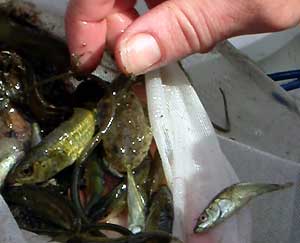
|
Assignment - Seminar 12
DUE DATES
Wednesday
seminar sections: due Wed April 16, 4:30 PM
Friday Seminar
sections: due Thurs April 17, 4:30 PM (Fri is a holiday)
Friday seminars ONLY: assignments can be submitted by email, to:
lgosselin@tru.ca (no later than 4:30 PM).
Please note that if you submit your assignment by email, it will be
printed out in black and white (no colour) and this printed copy will
be marked.
|
 |
Life
history strategies
This assignment is a story of two little
fishies.
Two
fish
species coexist in several lakes in the Yukon Territory, but do not
compete
for limiting resources. Under ideal conditions, the
2 species have the following life history traits:
- the 2 species have the same R0
= 1.64;
- species 1 is iteroparous
and species
2 is semelparous;
- if left undisturbed (i.e. no
predators,
diseases, extreme physical changes, etc.) the 2 species have
survivorship schedules
as shown in the tables below;
- the iteroparous species reproduces
for the first time when they are
one year old. Then, from that point on, fertility increases
each year of their life as the individuals grow older and larger.
- in both species, all reproduction
takes
place during one brief period of the year and the population counts are
made shortly after breeding.
A recent census of the Sx
values of these 2 species in 2 lakes in the Yukon revealed the same
total population size (448) and same age structure in both lakes (see
tables below).
Start by completing the life tables
for
each species according to the life history traits listed above.
The survivorship schedule (lx) is already given, and the current
number of fish in each age class are provided.
However, you
will have to 'design' the fecundity schedules of your 2 species so that
they correspond to the traits listed above.
| Age |
Species 1: Ofteneis beteri |
Sx
|
lx |
| 0 |
160
|
1 |
1
|
112
|
0.7
|
2
|
80
|
0.5 |
3
|
48
|
0.3 |
4
|
32
|
0.2 |
5
|
16
|
0.1 |
6
|
0
|
0
|
|
|
| Age |
Species 2: Woncis enufi |
| Sx |
lx |
0
|
204
|
1
|
1
|
142
|
0.7
|
2
|
102
|
0.5
|
3
|
0
|
0
|
|
|
|
|
|
|
|
|
|
|
What would happen to these 2 species in
each of the following lakes?
1. The first lake, lake
Bigbite, is inhabited by predators that feed heavily on these 2 fish
species, although they primarily feed on larger fish. These
predators ignore fish younger than 2 years, as they are too
small. However, each year they do kill some of the 2 year old
fish, reducing survivorship by 30%
of what it would be in the absence of the predator. The predators
feed even more heavily on the older fish, decreasing survivorship of
the 3 and 4 year olds by 60%, and decreasing survivorship of the 5 year
old fish by 80% of what it would be in the absence of the predator.
2. The second lake, lake
Steamy, has no predators but is shallower than lake Bigbite. As a
result, on
particularly hot summers the water of lake Steamy warms up to a point
where the embryos are unable to develop normally. When this
happens all the embryos of both species
die shortly after being spawned, although the older fish are not
affected. These unusually warm conditions occur once every 5
years. The rest of the time the summers are cooler and as a
result the fish embryos develop and survive "normally".
The next hot summer in the region is expected to occur 5 years from
now. You will have to think carefully about how to use Populus
to find
out what happens to the populations in this lake; there is no direct
way
to tell Populus that the survivorship changes from one year to
the
other, so you'll have to find a different way (for example, work out
population
changes over short periods, such as 1 or 2 years at a time, and change
the survivorship values as appropriate).
For each lake, which species would be
most
successful? Also, for
each of the 2 lakes, explain why
each
species would do well or poorly
(i.e. relate your predicted
outcome to the particular
life history traits of the species).
Provide
graphs, as needed, to support
your conclusions. Also be sure to include life tables listing all the
population parameters (vital statistics) for the ideal conditions,
as well
as modified life tables as appropriate for the 2 lakes.
Back to the
Population
Biology Assignments page
© Copyright 2014 by L.A.
Gosselin, all rights reserved

